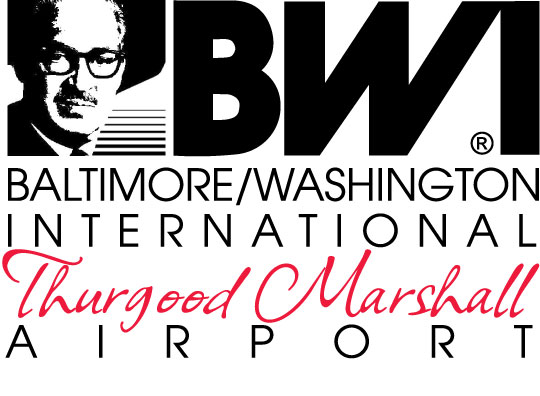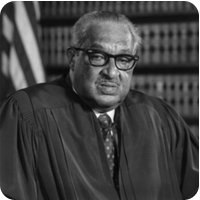- To & From BWI
- At BWI
- Flying With Us
Thurgood Marshall
Biography

Marshall graduated from Lincoln University in 1930. Afterward, Marshall thought of applying to his hometown law school at the University of Maryland School of Law. He did not, however, because he knew the school’s formal segregation policy would have denied him admission. Instead, Marshall sought admission and was accepted at Howard University. He was influenced by its dynamic new dean, Charles Hamilton Houston, who instilled in his students the desire to apply the tenets of the Constitution to all Americans. Paramount in Houston’s outlook was the need to overturn the 1898 Supreme Court ruling, Plessy v. Ferguson which established the legal doctrine called “separate but equal”.
Marshall’s first major court case came in 1933 when he successfully sued the University of Maryland to admit a young African American Amherst University graduate named Donald Gaines Murray. Applauding Marshall’s victory, author H.L. Mencken wrote that the decision of denial by the University of Maryland Law School was “brutal and absurd,” and they should not object to the “presence among them of a self-respecting and ambitious young Afro-American well prepared for his studies by four years of hard work in a class A college.”
Thurgood Marshall followed his Howard University mentor, Charles Hamilton Houston to New York and later became Chief Counsel for the National Association for the Advancement of Colored People (NAACP). During this period, Mr. Marshall was asked by the United Nations and the United Kingdom to help draft the constitutions of the emerging African nations of Ghana and what is now Tanzania. It was felt that the person who so successfully fought for the rights of America’s oppressed minority would be the perfect person to ensure the rights of the White citizens in these two former European colonies. After amassing an impressive record of Supreme Court challenges to state-sponsored discrimination, including the landmark Brown v. Board decision in 1954, President John F. Kennedy appointed Thurgood Marshall to the U.S. Court of Appeals for the Second Circuit. In this capacity, he wrote 112 opinions, none of which was overturned on appeal. Several of his dissenting opinions were eventually adopted as majority opinions by the Supreme Court. In 1965 President Lyndon Johnson appointed Judge Marshall to the office of U.S. Solicitor General. Before his subsequent nomination to the United States Supreme Court in 1967, Thurgood Marshall argued 32 cases before the Supreme Court, 18 of those on behalf of the federal government. Indeed, Thurgood Marshall represented and won more cases before the United States Supreme Court than any other American during his time.
Until his retirement from the highest court in the land, Justice Marshall established a record for supporting the voiceless American. Having honed his skills since the case against the University of Maryland, he developed a profound sensitivity to injustice by way of the crucible of racial discrimination in this country. As an Associate Supreme Court Justice, Thurgood Marshall leaves a legacy that expands that early sensitivity to include all of America’s voiceless. Justice Marshall died on January 24, 1993.
Dedications
The University of Maryland School of Law which Marshall fought to desegregate, renamed and dedicated its law library in his honor.
The University of California, San Diego named one of its colleges after Thurgood Marshall.
On February 14, 1976, the law school at Texas Southern University was formally named The Thurgood Marshall School of Law.
A statue of Thurgood Marshall was placed at the heart of downtown Baltimore outside the Federal Building and U.S. Courthouse at the corner of Pratt Street.
In 1996, the Thurgood Marshall Memorial Lawyers’ Mall at the Annapolis State House Square was unveiled.
On October 1, 2005, Baltimore/Washington International Airport is renamed Baltimore/Washington International Thurgood Marshall Airport in his honor.
Thurgood Marshall Tribute

Near the Observation Gallery is the Thurgood Marshall Tribute, an interesting exhibit of the life of one of the country’s leading civil rights activists.
A Thurgood Marshall Timeline
1930
Mr. Marshall graduates with honors from Lincoln University (cum laude)
1933
Receives law degree from Howard University (magna cum laude); begins private practice in Baltimore
1934
Begins to work for Baltimore branch of NAACP
1935
With Charles Houston, wins first major civil rights case, Murray v. Pearson
1936
Becomes assistant special counsel for NAACP in New York
1940
Wins first of 29 Supreme Court victories (Chambers v. Florida)
1944
Successfully argues Smith v. Allwright, overthrowing the South’s “white primary”
1948
Wins Shelley v. Kraemer, in which Supreme Court strikes down legality of racially restrictive covenants
1950
Wins Supreme Court victories in two graduate-school integration cases, Sweatt v. Painter and McLaurin v. Oklahoma State Regents
1951
Visits South Korea and Japan to investigate charges of racism in U.S. Armed Forces; reported that the general practice was one of “rigid segregation”
1954
Wins Brown v. Board of Education of Topeka, landmark case that demolishes legal basis for segregation in America
1961
Appointed circuit court judge, authors 112 opinions, none of which were overturned on appeal (1961-1965)
1961
Appointed circuit court judge, authors 112 opinions, none of which were overturned on appeal. (1961-1965)
1965
Appointed U.S. solicitor general by President Lyndon Johnson; he argued 18 cases for the federal government (1965-1967)
1967
Becomes first African American elevated to U.S. Supreme Court (1967-1991)
1991
Retires from the Supreme Court
1993
Dies at 84
Resources and books consulted:
New York Times, January 25, 1993, A1
Thurgood Marshall – American Revolutionary by Juan Williams